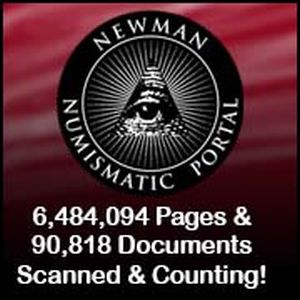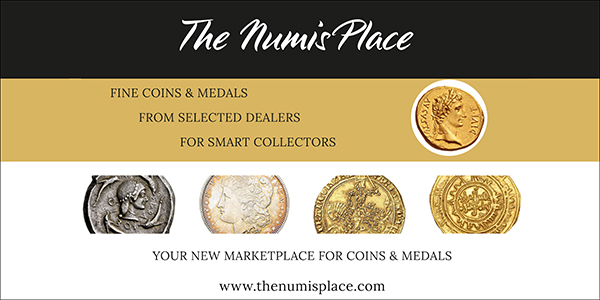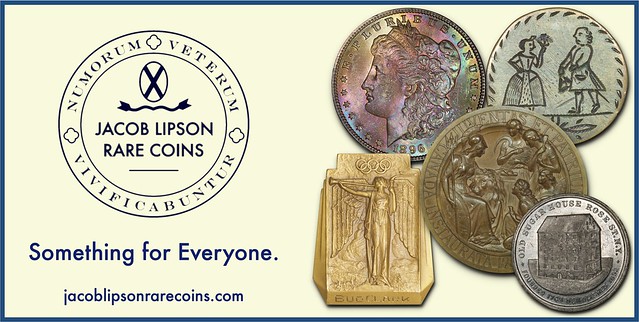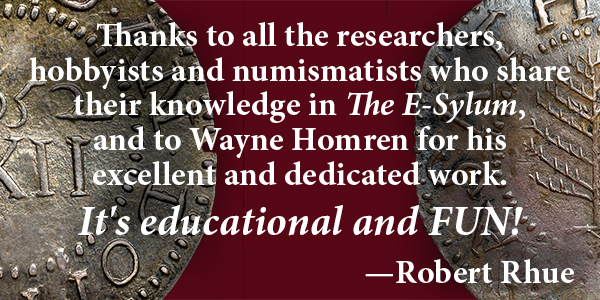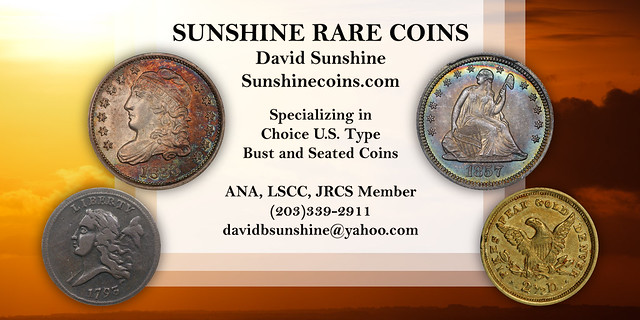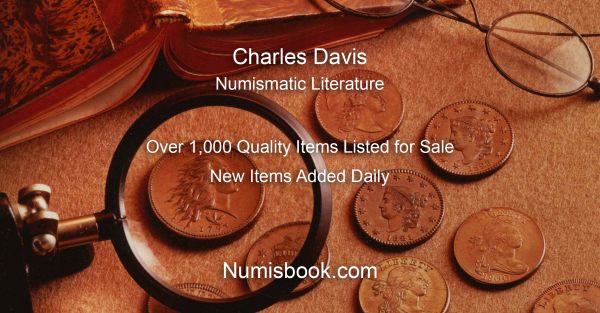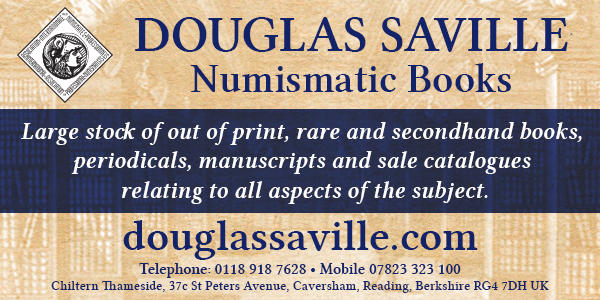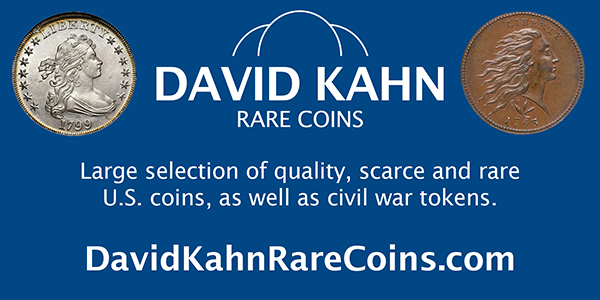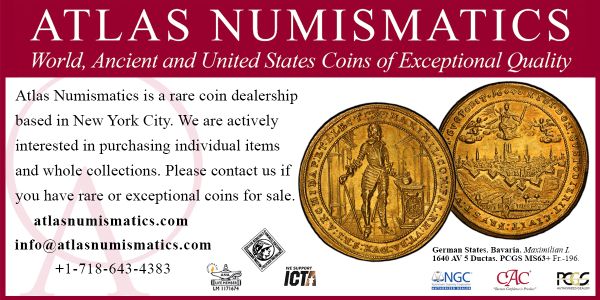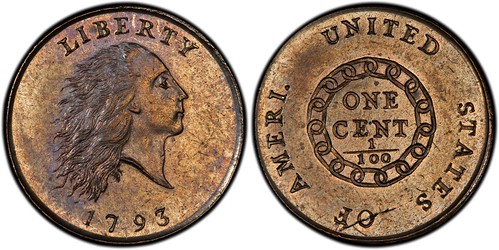
Visit our NBS Sponsors
About UsThe Numismatic Bibliomania Society is a non-profit association devoted to the study and enjoyment of numismatic literature. For more information please see our web site at coinbooks.org SubscriptionsThose wishing to become new E-Sylum subscribers can go to the following web page
Subscribe
MembershipThere is a membership application available on the web site Membership Application To join, print the application and return it with your check to the address printed on the application. Print/Digital membership is $40 to addresses in the U.S., and $60 elsewhere. A digital-only membership is available for $25. For those without web access, write to: Jeff Dickerson, Treasurer AsylumFor Asylum mailing address changes and other membership questions, contact Jeff at this email address: treasurer@coinbooks.org SubmissionsTo submit items for publication in The E-Sylum, write to the Editor at this address: whomren@gmail.com BUY THE BOOK BEFORE THE COINSale Calendar |
- WAYNE'S WORDS: THE E-SYLUM NOVEMBER 9, 2025
- KOLBE & FANNING NOVEMBER 2025 SALE HIGHLIGHTS
- NEW BOOKS: COINS OF ENGLAND 2026
- NEW BOOK: SCARBOROUGH MEDALS & TOKENS
- NEWMAN PORTAL ADDS 2025 SUMMER FUN VIDEOS
- VIDEO: FINAL DAYS OF THE DAHLONEGA MINT
- L.W. HOFFECKER ARCHIVE DISCOVERED
- NOTES FROM E-SYLUM READERS: NOVEMBER 9, 2025
- STACK'S BOWERS PARENT BECOMES GOLD.COM
- VOCABULARY TERM: SANDBLASTED, SANDBLASTING
- GEORGE BULL (1838-1886)
- NUMISMAGRAM MEDAL SELECTIONS: NOVEMBER 9, 2025
- STACK'S BOWERS NOVEMBER 2025 CURRENCY SHOWCASE
- HERITAGE: U.S. ERROR CURRENCY SHOWCASE
- DAVISSONS E-AUCTION 52 SELECTIONS
- HERITAGE: ANDES COLLECTION OF COLUMBIAN BANKNOTES
- KUENKER AUCTION SALE 433
- KUENKER AUCTION SALES 434-435
- WAYNE'S NUMISMATIC DIARY: NOVEMBER 9, 2025
- THE BUNNIK ROMAN COIN HOARD
- CELTIC QUARTER STATER FOUND IN SAXONY
- 1793 NEWSPAPER ARTICLE ON THE NEW CENTS
- PATHFINDER 1943 STEEL CENT ENVELOPE
- WASHINGTON, COOLIDGE, TRUMP, LAW AND TRADITION
- STATUE OF DICKIN MEDAL DOG BING
- CHOCTAW NATION CONFEDERATE SCRIP
- LOOSE CHANGE: NOVEMBER 9, 2025
- ABOUT THIS ISSUE: NOVEMBER 9, 2025
Content presented in The E-Sylum is not necessarily researched or independently fact-checked, and views expressed do not necessarily represent those of the Numismatic Bibliomania Society.
WAYNE'S WORDS: THE E-SYLUM NOVEMBER 9, 2025
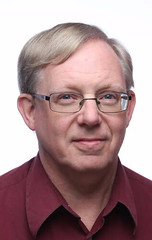 New subscribers this week include:
Owen McKee, courtesy Terry Freed;
Isaac Solomon,
Charlie P. Coffey,
Len Buth,
and
John Csaszar.
Welcome aboard! We now have 6,782 subscribers.
New subscribers this week include:
Owen McKee, courtesy Terry Freed;
Isaac Solomon,
Charlie P. Coffey,
Len Buth,
and
John Csaszar.
Welcome aboard! We now have 6,782 subscribers.
Thank you for reading The E-Sylum. If you enjoy it, please send me the email addresses of friends you think may enjoy it as well and I'll send them a subscription. Contact me at whomren@gmail.com anytime regarding your subscription, or questions, comments or suggestions about our content.
This week we open with more numismatic literature sale highlights, three new books, updates from the Newman Numismatic Portal, notes from readers, and more.
Other topics this week include the coins of England, the final days of the Dahlonega Mint, Gold.com, sandblasting, Mint cabinet curator George Bull, fixed price and auction previews, Columbian banknotes, the Bunnik hoard, brandy new 1793 and 1943 cents, the Dickin Medal, and script payable on Confederate notes.
To learn more about the Grand Duke Georgii Mikhailovich's legendary collection, the Henry C. Miller collection, Scarborough medals and tokens, the Lyman William Hoffecker archive, a mystery spiked large cent pair, the Cathedral of St. Peter & St. Paul in Philadelphia, William A. Philpott Jr., the American Colonization Society, Horatio Rust, and Choctaw Nation scrip, read on. Have a great week, everyone!
Wayne Homren
Editor, The E-Sylum
KOLBE & FANNING NOVEMBER 2025 SALE HIGHLIGHTS
Here are some more highlights from the upcoming Kolbe & Fanning November 22, 2025 numismatic literature sale. -Editor
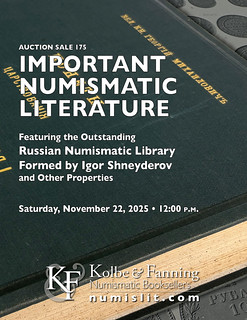 Kolbe & Fanning Numismatic Booksellers will be holding our 175th auction sale on Saturday, November 22, 2025, starting at 12:00 noon eastern time. The sale features excellent material on U.S. numismatics from the library of John Hoskins, in addition to the outstanding library on Russian numismatics formed by Igor Shneyderov. With over 500 lots, there is something for everybody.
Kolbe & Fanning Numismatic Booksellers will be holding our 175th auction sale on Saturday, November 22, 2025, starting at 12:00 noon eastern time. The sale features excellent material on U.S. numismatics from the library of John Hoskins, in addition to the outstanding library on Russian numismatics formed by Igor Shneyderov. With over 500 lots, there is something for everybody.
Some highlights of this first sale include:
NEW BOOKS: COINS OF ENGLAND 2026
The 2026 editions of Coins of England & the United Kingdom are available for preorder from Sovereign Rarities. Here's the announcement. -Editor
Sovereign Rarities are proud to present the 2026 editions of the Coins of England and the United Kingdom, otherwise known as the Standard Catalogue of English Coins, the historic reference work for British coins.
Comprising Pre-decimal and Decimal issues, and with over 5,000 price revisions, these are not only the go-to guide for collectors and detectorists alike, but providers of insight into British history itself.
With delivery expected in late November, we offer the Pre-decimal issue for £35, the Decimal issue for £25, but if you order both, we can offer a discount to £55 for the pair to include UK shipping.
Pre-order now in time for Christmas!
NEW BOOK: SCARBOROUGH MEDALS & TOKENS
John Csaszar & Peter Machulec have published a new book on the medals and tokens of Scarborough, Canada. Congratulations. Here's the Foreword by Paul Johnson. The 36-page book can be purchased for $10 plus $5 shipping within Canada and $8 within the United States. -Editor
 Janusz (Peter) Machulec and John Csaszar of Scarborough have developed a wonderful book on the subject of
Scarborough, Ontario related medals and medallions. Both Peter and John are long me members of the
Scarborough Coin Club that have a keen interest in these medals.
Janusz (Peter) Machulec and John Csaszar of Scarborough have developed a wonderful book on the subject of
Scarborough, Ontario related medals and medallions. Both Peter and John are long me members of the
Scarborough Coin Club that have a keen interest in these medals.
The first part of the book provides some general information about the history of Scarborough which dates back to its founding in 1796. Scarborough is a thriving city with a population of more than 600,000 people.
NEWMAN PORTAL ADDS 2025 SUMMER FUN VIDEOS
The latest additions to the Newman Numismatic Portal are videos from the 2025 Summer FUN show. Project Coordinator Len Augsburger provided the following report. -Editor
Newman Portal Adds FUN Videos
 Courtesy of the Florida United Numismatists (FUN), Newman Portal has added six videos representing presentations given at the 2025 Summer FUN convention. Speakers include Tom Scopp, Randy Campbell, William Jones, Steve Howard, Jay Chamberlain, and Bob Hurst. The FUN convention returns to Orlando with its 71st convention in early 2026, January 8-11. Many thanks to FUN board member Steve Martin for assistance with this content.
Courtesy of the Florida United Numismatists (FUN), Newman Portal has added six videos representing presentations given at the 2025 Summer FUN convention. Speakers include Tom Scopp, Randy Campbell, William Jones, Steve Howard, Jay Chamberlain, and Bob Hurst. The FUN convention returns to Orlando with its 71st convention in early 2026, January 8-11. Many thanks to FUN board member Steve Martin for assistance with this content.
THE BOOK BAZARRE
VIDEO: FINAL DAYS OF THE DAHLONEGA MINT
The David Lisot Video Library on the Newman Numismatic Portal can be found at:
https://nnp.wustl.edu/library/multimediadetail/522852
We highlight one of his videos each week in The E-Sylum. Here's another one from 2016 with Carl Lester speaking about the Dahlonega Mint (Part 4 of 4). -Editor
L.W. HOFFECKER ARCHIVE DISCOVERED
El Paso numismatist Jason Elwell submitted this announcement of a recent archive discovery. Thanks, and congratulations on the find! -Editor
 A once-in-a-lifetime numismatic event has taken place along the U.S./Mexican border. In the desert city of El Paso, Texas, surviving documents and artifacts belonging to the late Lyman William Hoffecker (1868-1955), designer of the 1935 Old Spanish Trail / El Paso half dollar, have been discovered. These items, which have remained unknown to the numismatic community for the last seventy (70) years, were discovered during renovation efforts of the L.W. Hoffecker property. To those not familiar with L.W. Hoffecker, he was the originator of the Old Spanish Trail (El Paso) half dollar and was a former President of the American Numismatic Association.
A once-in-a-lifetime numismatic event has taken place along the U.S./Mexican border. In the desert city of El Paso, Texas, surviving documents and artifacts belonging to the late Lyman William Hoffecker (1868-1955), designer of the 1935 Old Spanish Trail / El Paso half dollar, have been discovered. These items, which have remained unknown to the numismatic community for the last seventy (70) years, were discovered during renovation efforts of the L.W. Hoffecker property. To those not familiar with L.W. Hoffecker, he was the originator of the Old Spanish Trail (El Paso) half dollar and was a former President of the American Numismatic Association.
During renovations, new homeowners John and Naiomi Falvey found the items tucked away in the carriage house located at the back of the old L.W. Hoffecker house. Soon after, Falveys would reach out to local El Paso numismatist and award-winning numismatic author Jason Elwell (Numismatics of the Borderland, 1st Edition, Honorable Mention Best Reference Book 2024, International Latino Book Awards), asking him if he would like to have the L.W. Hoffecker records. As the Falveys knew the L.W. Hoffecker records were of historic significance, they felt it was important to find the right person to give the files to. As a numismatist, Jason Elwell saw the importance of preserving these documents and artifacts and is now the new owner of those items. Jason Elwell would also become the new owner of L.W. Hoffecker's double-door steel vault, which resided within the same carriage house where the files were found. Currently, these items are part of the Jason Elwell Numismatic Collection.
NOTES FROM E-SYLUM READERS: NOVEMBER 9, 2025
More on Postmarked Scrip Notes
Regarding postmarked scrip notes,
David Gladfelter writes:
"Todd Sciore discovered that E. H. Fowler, who issued scrip notes from Ellisburg, N. J. In 1862, was its postmaster, but his notes aren't postmarked on the back. That's because he wasn't the postmaster in 1862 so he didn't have the circular date stamp then."
Todd adds:
"In addition to some examples of merchant scrip, I've also found examples with Victorian trade cards where the local shopkeeper was also the postmaster. I've attached an example of a typical card likely given out by a local druggist and another that actually says postmaster on it."
Thanks. -Editor
To read the earlier E-Sylum article, see:
Alonzo H. Sawyer, Postmaster : Alonzo H. Sawyer, Postmaster
(https://www.coinbooks.org/v28/esylum_v28n44a11.html)
Other topics this week include the Restrike 1804 dollars, Dave Lange's Coin Collecting Albums books, and using Ancestry.com for research. -Editor
STACK'S BOWERS PARENT BECOMES GOLD.COM
Stack's Bowers parent company A-Mark Precious Metals is rebranding and changing its name and website to Gold.com. Here's an excerpt from the press release - see the complete article online. -Editor
A-Mark Precious Metals (Nasdaq: AMRK), a fully integrated alternative assets platform that offers an extensive range of precious metals, numismatic coins, and collectibles to consumers, collectors, and institutional clients worldwide, today announced a corporate rebranding initiative that will change its name to "Gold.com" and transfer its common shares from the Nasdaq to the New York Stock Exchange (NYSE), effective Dec. 2, 2025. The shares of the Company, to be known as Gold.com, are expected to trade under the symbol "GOLD."
This strategic evolution better aligns the Company's corporate identity with its category leadership in precious metals, coins, currency, and other collectibles, with services spanning Direct-to-Consumer, Wholesale Sales & Ancillary Services (including proprietary minting, logistics, and secure storage capabilities), and Secured Lending. With $11.9 billion in revenues for the 12 months ending Sept. 30, 2025, and a strong balance sheet, Gold.com will operate as one of the most comprehensive vertically integrated precious metals platforms for global customers, retailers, collectors, and institutional clients.
VOCABULARY TERM: SANDBLASTED, SANDBLASTING
Here's another entry from Dick Johnson's Encyclopedia of Coin and Medal Terminology. -Editor
Sandblasted, Sandblasting. An abrasive blasting process; the pelting of a metal surface with very fine sand to break up a smooth finish. This action produces a matte surface of very low reflectiveness. A tiny individual point of impact with a grain of sand is called a crater, thousands of these would appear in a small area of a medallic surface after sandblasting, also called abrasive blasting. These craters are ideal for processing with a liquid or slurry, as they retain liquid until it forms a chemical reaction with the metal. Sandblasting is often the first step in a medal finishing department because it can accommodate several subsequent steps as metal coloring, relieving, torch finish and such. The process was first developed at the Paris Mint circa 1880. Once the surface is sandblasted it is called matte, or the French term is sablé.
GEORGE BULL (1838-1886)
E-Sylum Feature Writer and American Numismatic Biographies author Pete Smith submitted this article on U.S. Mint Cabinet curator George Bull. Thanks! -Editor

A Description of Ancient and Modern Coins, in the Cabinet Collection
at the Mint of the United States
This week I went down a research rabbit hole and came up somewhat short of catching the rabbit. My interest started with William Spohn Baker who wrote a book about Washington medals. This led me to James Ross Snowden who also wrote a book about Washington medals. Next came Snowden's 1860 Mint Manual. Turns out that book was compiled by a little-known curator of the Mint Cabinet, George Bull.
George Bull was born in Towanda, Pennsylvania, on May 21, 1838, the son of Colonel James Perry Bull (1802-1842) and Ann E. Wallis (1809-1886). His sister Ann Wallis Bull (1830-1893) married Orville Hitchcock Platt who served as senator from Connecticut.
NUMISMAGRAM MEDAL SELECTIONS: NOVEMBER 9, 2025
Numismagram's Jeremy Bostwick sent along these five medals from his most recent upload of new material to his site. For all of the new items, please visit https://www.numismagram.com/inventory. -Garrett
103267 | UNITED STATES. Philadelphia. Cathedral of St. Peter & St. Paul silvered white metal Medal. Issued 1864 (80mm, 223.19 g, 12h). By Anthony Paquet.
CATHEDRAL OF ST. PETER AND ST. PAUL, PHILADELPHIA, frontal view of the cathedral; in two lines in exergue, BEGUN 1846 / COMPLETED 1864 // TU ES PETRUS ET SUPER HANC PETRAM AEDIFICABO ECCLESIAM MEAM / VAS ELECTIONIS EST MIHI ISTE UT PORTET NOMEN MEUM CORAM GENTIBUS, perspective interior view, from a vantage point just left of center. Edge: A few light marks as noted, otherwise plain.
STACK'S BOWERS NOVEMBER 2025 CURRENCY SHOWCASE
Stack's Bowers will be hosting their November 2025 Showcase Auction of United States Currency, presented in two sessions, both to be held on Thursday, November 13. Session 6, starting at 12 PM PT, offers an assortment of Colonial-era notes, as well as a variety of Obsolete issues. Session 7 presents an impressive assortment of U.S. type notes. -Garrett
VT-1. Vermont. February 1781. 1 Shilling. PMG Very Fine 20 Net. Severed & Reattached, Repaired. No. 2622. Serial number in cartouche along the top margin. Signatures of both Walbridge and Fasset penned distinctly in a stacked arrangement. The signature of Walbridge is notably thicker than that of Fasset which appears along the bottom margin. Dimensions are 71mm by 90mm with some roughness evident while the basic design resembles that of the notes issued by both Connecticut and Rhode Island during the period. Border cuts at left and right depicting thin vines which Ford dubbed the "simple swaying vine" which support a keystone-like frieze emblazoned "VERMONT CURRENCY" with both the serial number and denomination below. Text and obligation may be seen at center with a Fugioesque chain with 14 links encircled by motto "VERMONT CALLS FOR JUSTICE" which is largely unobscured by the repairs best observed on the verso. A similar arrangement is noticed on the verso with the denomination stacked above the counterfeit warning and imprint for Judah P. Spooner along with a date of "1781." The aforementioned repairs are best observed along the left and right margins with stiff paper strips applied to reinforce the brittle paper body while a similar repair has been applied to mitigate the split evident along the horizontal crease. Some minor chips may be observed along the margins but are noted for the sake of posterity as this is one of the finest Vermont Colonials that was once part of the John J. Ford, Jr. Collection. To emphasize and to paraphrase the description from Ford III, this example is very likely one of the finest known for its type and denomination and vastly superior to many of its known counterparts. For the collector looking to acquire a quality Vermont Colonial for their own collection this is an opportunity not to be missed as opportunities comparable to Ford are rare even among exceptional auctions. PMG comments "Severed & Reattached, Repaired."
HERITAGE: U.S. ERROR CURRENCY SHOWCASE
Heritage published the following article in their latest Currency News email entitled Showcase Spotlight: U.S. Error Currency Showcase. -Garrett
As most US currency collectors know, the US Government began issuing Large Size paper money in 1861 to help finance the Civil War. The notes were printed through the National Bank Note Company and American Bank Note Company, both in New York. These companies were joined by the National Currency Bureau in 1863, which became the Bureau of Engraving and Printing in 1869. In these early days, every step of the printing process needed human hands. Each step was closely monitored from beginning to end to produce attractive, quality banknotes and to avoid releasing errors and misprinted notes into circulation. This hands-on approach with repeated inspection resulted in very few Large Size Errors reaching circulation. The few that escaped unnoticed would become numismatic collectors' trophies once discovered.
DAVISSONS E-AUCTION 52 SELECTIONS
Allan Davisson wrote this overview of the Peter Bartlett Collection of Greek and Roman Coins in his firm's Auction 52, which closes on November 19, 2025. Select items are discussed afterwards. -Garrett
E-Auction 52, closing Wednesday, November 19th 2025, is online now!
This sale features our first offering from The Peter Bartlett Collection. Peter's carefully assembled collection features an exceptional array of classic Greek and Roman coinage. We discussed Peter's background in our introductory note, as a Life Fellow of the ANS and a world-renowned expert in coins of the Visigoths. The pieces we have chosen for this first offering from his collection are from Magna Graecia through mainland Greece and the Peloponnese, and are representative of his collection as a whole – beautiful style, well centered pieces on large flans, including many rare types and denominations, purchased from significant auctions and important dealers since the 1960s.
We have included some highlights below, along with a few exceptional pieces from another consignor, but do take a minute to browse the full 60 lots from the Bartlett Collection that are included in our Greek section. They represent a rare opportunity to acquire pieces of remarkable quality.
HERITAGE: ANDES COLLECTION OF COLUMBIAN BANKNOTES
Heritage published the following article in their latest Currency News email entitled Showcase Spotlight: The Andes Collection of Columbian Banknotes World Paper Money Showcase Auction by Morgan Yount. -Garrett
Our November 23 auction of The Andes Collection of Colombian Banknotes offers a radiant array of pieces sure to captivate collectors. While the appeal of paper currency often lies in its vibrant colors and intricate designs, such as seen on the striking Colombia Banco de la Republica 1 Peso Oro 6.8.1938 Pick 385a Commemorative PMG Choice Uncirculated 63, the notes' attractiveness only scratches the surface of what makes these artifacts appealing to collectors. Arguably, one of the most compelling aspects of currency is its ability to capture the story of the moment in time in which it was created. Few examples illustrate this better than the 1900 República de Colombia 1, 5, and 10 Pesos. At first glance, these notes, rendered in stark black-and-white lithography, stand in sharp contrast to the more ornate pieces in the collection. However, their minimalist design is not a flaw, but rather a telling reflection of the political and economic turmoil gripping Colombia at the turn of the century.
KUENKER AUCTION SALE 433
Seven extensive private collections of ancient coins will be up for sale at Künker's upcoming November auctions. Look forward to the full range of ancient coins, with a particular focus on Roman Provincial Coinage. Künker is presenting the collections of Willi Schleer, Christoph Buchhold, Dr. Kaya Sayar, Dr. Carl Friedrich Zschucke, Dr. W. R., as well as the collections of a North German friend of antiquity and a Hessian pharmacist.
Here's the press release for sale 433. -Garrett
Those interested in coins of Roman Asia Minor will be familiar with the name of Willi Schleer. He often let young researchers view his collection, which is why many of his coins were published. With much enthusiasm for the subject and extensive knowledge, this collector succeeded not only in assembling an extremely comprehensive collection of Roman Provincial issues. Willi Schleer also made sure that the specimens in his collection are often by far the best preserved out there.
Those familiar with Greek aesthetics and Roman portraiture may initially be put off by the civic coinage of Asia Minor. After all, they do not align with our visual habits. However, no other coins of antiquity offer such direct insight into the political, religious and cultural life of wealthy provincial populations.
Provincial Roman coinage depict bridges, temples and images of gods. They refer to regional festivals and cults, some of which are depicted in great detail. These coins celebrate the emperor, particularly if he visited the province, perhaps even the city itself. Coins from Asia Minor are the best source to understand the inscriptions of cities, and to reconstruct a small part of ancient everyday life based on all available evidence.
Enjoy the many images from the past of the Roman Empire and take the time to delve into the details on the reverse. The Willi Schleer Collection is ideal for this because, as mentioned above, it is very rare to see Roman Provincial Coinage of this quality!
KUENKER AUCTION SALES 434-435
Seven extensive private collections of ancient coins will be up for sale at Künker's upcoming November auctions. Look forward to the full range of ancient coins, with a particular focus on Roman Provincial Coinage. Künker is presenting the collections of Willi Schleer, Christoph Buchhold, Dr. Kaya Sayar, Dr. Carl Friedrich Zschucke, Dr. W. R., as well as the collections of a North German friend of antiquity and a Hessian pharmacist.
Here's the press release for sales 434 and 435. -Garrett
The first part of the Sayar Collection, featuring coins from the southern Turkish regions of Lycia, Pamphylia and Cilicia, was auctioned off on 14 March 2024. Now, the second part containing all other regions is being offered at eLive Premium Auction 434. The auction presents more than 850 lots, mainly from the eastern Mediterranean. As well as the expected coins from Asia Minor, the collector was interested in the entire Greek cultural region, which is why the spectrum of the Sayar Collection spans from Gaul to Egypt. The focus is on cities of Asia Minor. Those who enjoy travelling through Asia Minor will recognize many familiar names in the auction catalog.
WAYNE'S NUMISMATIC DIARY: NOVEMBER 9, 2025
On Thursday I went to my day job in the morning but after a meeting ended at Noon I made a beeline up to Baltimore for the Whitman Baltimore Expo. I was just parking my car when I got a text from longtime advertiser Bob Steinberg. I met up with him in the lobby and we had a nice conversation.
At registration I was given a card for a drawing at the Whitman table and made my way over there to speak with Billie Blattel, who I work with on Whitman's E-Sylum advertising. After scratching off a prize card I was given my pick of books from a table and I chose a blank Red Book Journal, which I hadn't seen before.
THE BUNNIK ROMAN COIN HOARD
A October 2023 Roman coin hoard found in the Netherlands has been analyzed. -Editor
Two metal detectorists uncovered a Roman treasure hoard containing hundreds of ancient coins in a meadow near Bunnik, a town in the Dutch province of Utrecht. The cache dates to the years around the Roman invasion of Britain under Emperor Claudius.
The find is remarkable because it blends Roman and British money in one stash. It also links a quiet Dutch field to events that reshaped life on both sides of the North Sea.
CELTIC QUARTER STATER FOUND IN SAXONY
Alan Luedeking passed along this article about a recent Celtic gold coin find in Germany. Thanks. I've always had a soft spot for simple, stylized, Picassoesque Celtic coin designs. -Editor
The gold coin unearthed by a metal detectorist in a field in Gundorf, northwest of Leipzig in Germany, may be small, but it belies a considerable history. The Saxon State Office of Archaeology, to which the finder Daniel Fest reported his discovery, has revealed that the two-gram, 2,200-year-old artifact is Saxony's oldest known coin. What's more, it's part of a larger story of 3rd-century B.C.E. trade in the region.
The office has confirmed the object is a Celtic coin, similar to pieces found in the formerly Celtic area of northern Bohemia. Today, that area sits at the northern edge of the Czech Republic and borders the Saxony region at Germany's eastern edge, where the piece was unearthed.
1793 NEWSPAPER ARTICLE ON THE NEW CENTS
Julia Casey recently discovered a April 5, 1793 newspaper article discussing the newly issued cents and submitted this transcription for our readers. Thank you! This is a wonderful discovery. -Editor
To the EDITOR of the NATIONAL GAZETTE.
SIR,
I HAVE lately heard much respecting the CENTS of the United States, and have obtained some with difficulty, having called five times at the national bank, and found "no cents to day."
PATHFINDER 1943 STEEL CENT ENVELOPE
Website visitor Marie Garcia writes:
Thank you! I didn't recall seeing one of these envelopes before, and my first search for information led me to the U.S. Army "pathfinder units" in WWII to scout enemy territory. But asking a more specific question brought back a pretty accurate AI-generated answer based on articles published ten or more years ago by Frank Van Valen at Stack's Bowers and yes, The E-Sylum. Here's what Google's Gemini said when I asked about the "pathfinder war time cent envelope." -Editor
WASHINGTON, COOLIDGE, TRUMP, LAW AND TRADITION
Len Augsburger passed along this New York Times article on the proposed Trump commemorative, noting that "Beth Deisher, Doug Mudd, Anthony Swiatek, and Bob Julian (the artist not the author) all weigh in." Thanks. Here's an excerpt - see the complete article online. -Editor
Nearly a century ago, the United States paused its 1920s roar to celebrate the 150th anniversary of the country's birth. There were speeches, a Philadelphia flop of a World's Fair, more speeches and a commemorative coin mostly remembered now as a numismatic misfire.
The 1926 coin featured the long-dead first president, George Washington, beside the very-much-alive current president, Calvin Coolidge, whose appearance broke with American convention not to depict a sitting president on money. The custom was inspired by Washington himself, who was so anti-monarchical he could have coined the phrase "No Kings."
STATUE OF DICKIN MEDAL DOG BING
A statue has been dedicated honoring the Dickin-medal-winning WWII dog Bing. -Editor
A dog, who played a key role during the Second World War, has been honoured with a special sculpture in Loughborough.
Bing, an Alsatian and Collie cross, was given to the army in 1945 when his owners could no longer feed him due to rationing.
He trained at the Army War Dog Training School in Hertfordshire, before being assigned to an army unit.
In 1947 Bing was awarded the PDSA Dickin Medal for bravery in service during WW2 – the animal equivalent to the Victoria Cross, given to soldiers who show extreme courage.
CHOCTAW NATION CONFEDERATE SCRIP
Stack's Bowers Currency Specialist Michael Moczalla published an article about a rare Civil War Indian Territory scrip note payable in Confederate currency. -Editor
Lot 6108 in our November 2025 Showcase auction is an interesting piece of scrip with a storied past. This $3 denominated piece dated May 16th, 1862 and bearing serial number 30 is signed and issued by Wm. Quesenbury, Major & Quarter Master, Indian Territory. In the Burgett tome, Indian Territory and Oklahoma Obsolete Notes and Scrip, it carries a Rarity-7 rating. This is, to the best of our knowledge, the first public offering of any example from here, as multiple searches through various auction records have turned up nothing. Graded Very Fine 20 by PMG with a minor repair and previous mounting, the penned signature and printed elements retain plenty of sharpness. It carries a conservative pre-sale estimate of $1,250-$1,750.
LOOSE CHANGE: NOVEMBER 9, 2025
Here are some additional items in the media this week that may be of interest. -Editor
A nice 1795 dollar has been discovered in Newcastle, England. -Editor
 A rare 18th-century American silver dollar discovered in the North East which could be worth about £15,000 is set to attract intense interest when it goes under the hammer next week.
A rare 18th-century American silver dollar discovered in the North East which could be worth about £15,000 is set to attract intense interest when it goes under the hammer next week.
The discovery, made in Newcastle, will be up for auction at Anderson & Garland's Stamps and Coins Auction.
Coin specialist Fred Wyrley-Birch authenticated the discovery and submitted it to the Numismatic Guaranty Corporation (NGC) for grading, where it earned an AU-55 score—confirming both its authenticity and exceptional condition.
"It is a wonderful example of an early American silver dollar," said Mr Wyrley-Birch.
To read the complete article, see:
Rare 1795 US Silver Dollar found in the North East
(https://www.thenorthernecho.co.uk/news/25598758.rare-1795-us-silver-dollar-found-north-east/)
Other topics this week include Coin Manhole Covers in Sweden, and Pokemon card thefts. -Editor
ABOUT THIS ISSUE: NOVEMBER 9, 2025
I recently used some of my spare time to start cleaning our garage. This week I took some old electronics to a recycler who weighed them and paid me $8. Then I loaded my car with old blinds, window fixtures and a large car part for a car our son no longer owns and hauled them to the county landfill. Cost me $8. So far I'm breaking even. Well, actually I'm down the gas and tolls, but we do have a neater, cleaner garage. And now I can see and reach the next layer of crap to clean out. Nothing numismatic to report besides what you've seen in my Baltimore Expo diary.
Here are some interesting non-numismatic articles I came across this week.
New York Zoo Hoax of 1874
(https://blog.newspapers.com/new-york-zoo-hoax-of-1874/)
The real truth about the Tudor succession comes to light. Literally.
(https://www.washingtonpost.com/opinions/2025/11/04/elizabeth-tudor-successor-james/)
This American soldier saved Charlemagne's cathedral in World War II
(https://www.militarytimes.com/veterans/military-history/2025/11/07/this-american-soldier-saved-charlemagnes-cathedral-in-world-war-ii/)
Moon Duchin on the ‘Mathematical Quagmire' of Gerrymandering
(https://www.nytimes.com/2025/11/03/science/duchin-math-elections-gerrymandering.html)
-Editor

